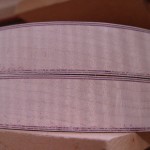I was a little surprised with Mica called me back to talk about the Coco Bolo and casually threw in a, “By the way – we’ve already started assembling your neck and body.”
For the body, I’ve selected a core of highly figured Western Flamed Maple (also referred to as Curly Maple) from Washington. The flame of the Maple body might seem subdued from the picture, but that’s mostly because this wood was just sanded. When the sealer coat is applied, you will see some serious figuring! Western Flamed Maple is not the standard core wood Alembic usually uses for this body shape, but it’s definitely going to look good against the dark Coco Bolo. Maple will help reinforce the high end of the frequency spectrum, and work with the Coco Bolo to deliver a full, well defined sound. On either side of the core, there are alternating pinstripes of Purpleheart (also known as Amaranth) and Maple. Although a useful tonewood itself, the Purpleheart pinstripes here are only ornamental, and won’t contribute much to the overall sound of the guitar. It has a striking purple color that darkens with age.
I’m doing something a little different with the neck. Ebony is not often used as a guitar neck laminate (although it is often used in bases), but I’ve chosen Gabon Ebony as the center laminate. The Gabon Ebony elements for this guitar are sourced, I believe, from Nigeria (or thereabouts). It is a very heavy wood that, when used in a neck-thru instrument, adds considerable sustain to the fundamental of the note – when you play a note, it lasts longer. Although difficult to see in the picture, the Ebony is flanked on either side with Maple stringers – thin veneers that separate the Ebony from the Purpleheart accent laminates. Outer laminates of Western Flamed Maple complete this 7-piece neck, a feature I’ve always wanted in a guitar. This Maple was selected in an attempt to match the characteristics of the core wood as much as possible. You can already see a high amount of figuring in the Maple neck laminates, a good sign of things to come!
A neck-thru guitar is one in which the neck literally goes through the body to the bottom of the bout. The sides of the body are glued on to the neck, then the top and back laminates are added (if they are bookmatched to the center of the guitar). Neck-thru guitars typically enjoy much greater sustain than set-necked guitars, where the neck is glued or bolted to the body. This is because with neck-thru construction, the strings do not travel over a joint (where the neck and body meet) that lessens the vibration of the strings. With neck-thrus, the choice of neck woods has a much greater effect on the tone of the instrument than set-necked guitars, and is the reason why such careful consideration was given to the choice of laminates here.


